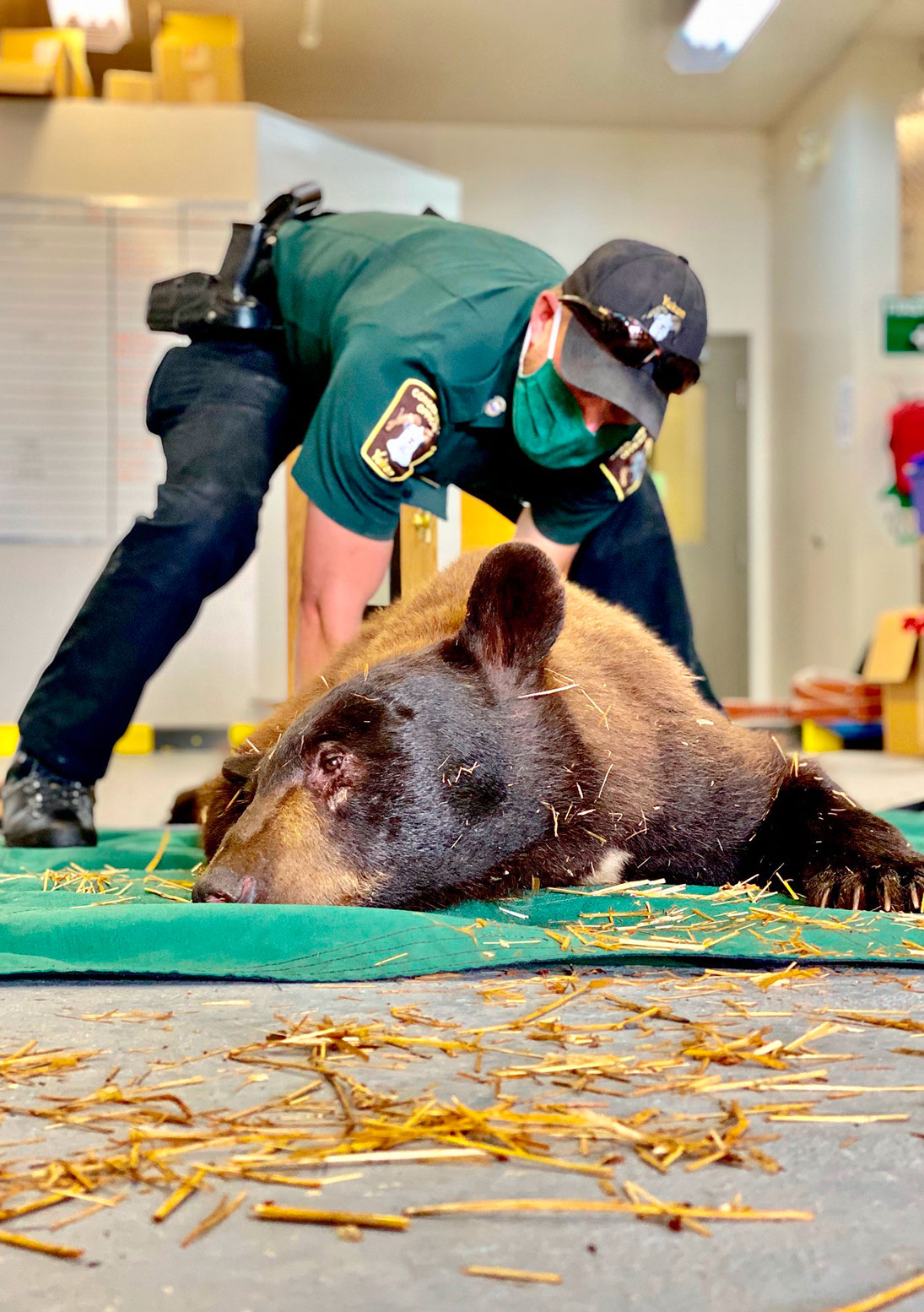
Photo by Photo Submitted
WORKING ON A BEAR – Conservation officer Aaron Koss-Young works on a tranquilized bear before its release last August. Photo courtesy ENVIRONMENT YUKON

Photo by Photo Submitted
WORKING ON A BEAR – Conservation officer Aaron Koss-Young works on a tranquilized bear before its release last August. Photo courtesy ENVIRONMENT YUKON
Thirty bears posing a risk of conflict with humans have been killed this year, conservation officer David Bakica said during a briefing Friday.
Thirty bears posing a risk of conflict with humans have been killed this year, conservation officer David Bakica said during a briefing Friday.
Bakica said 21 bears were shot by conservation officers and nine were killed by members of the public in defence of life and property.
Of the 30, 21 were black bears and nine were grizzlies, he said.
The number of bruins killed this year was down from the 33 shot last year and the 54 shot in 2018.
“There is still room for improvement,” he said, noting that proper management of bear attractants such as household garbage remains the primary tool for avoiding human-bear conflicts. “We want to get those numbers as low as we can.”
Bakica said there were a total of 134 bears incidents across the Yukon this year.
Conservation officers translocated 12 bears, six of which were fitted with satellite tracking collars, he explained.
Bakica said they are hoping the collars will provide more insight into the movement of translocated bears once they are released.
One of the six bears that was collared was shot in Riverdale on garbage day.
“It had been to multiple locations accessing garbage at multiple residences,” Diana Dryburgh-Moraal, an Environment Yukon communication officer, said in a statement Friday.
“Officers on scene assessed the situation as having a high public safety risk. That, and the fact that the bear had a conflict history, was enough for COs to make the difficult decision to kill the bear.”
Bakica said Yukoners need to remain vigilant when out in the wilderness because bears can still be out at this time of year, as some choose not to den until late fall or early winter.
Those Yukoners who are out and about should be carrying bear spray in a warm location to prevent it from freezing, he said.
The senior CO said there is a bear still out in Haines Junction, and it’s been seen on a moose carcass along the ski trails. It’s not clear how the moose died.
The bear, he said, is not likely to den until it’s finished scavenging the carcass.
Records show that since 2010, 2012 was the worst year with 61 bears killed: 10 grizzlies and 51 black bears.
The 54 bears killed in 2018 was the second-worst year going back to 2010.
The 23 bears killed in 2016 was the fewest bears killed in the last 11 years.
Bakica said the collars will record the bears’ locations every four hours. Once every four days the information will be uploaded to the satellite, he said.
He said they plan on collaring translocated bears for the next five years.
Managing attractants is key to reducing conflict incidents, he emphasized.
Bakica reiterated once a bear gets food rewards, it will keep coming back to the location.
Attractants can be everything from garbage to bird seed, to unfenced chicken coops or hunters hanging their moose meat, he explained.
In order to encourage thoughtful and responsible discussion, website comments will not be visible until a moderator approves them. Please add comments judiciously and refrain from maligning any individual or institution. Read about our user comment and privacy policies.
Your name and email address are required before your comment is posted. Otherwise, your comment will not be posted.
Comments (6)
Up 4 Down 5
FB on Dec 9, 2020 at 3:18 pm
Someone on facebook posted today that they saw a bylaw officer shooting one or more coyotes on Two Mile Hill on Dec. 8, at 9 pm. That is not acceptable. What is going on?
Up 7 Down 4
DA on Dec 9, 2020 at 10:16 am
Nathan Living,
Who doesn't have compost? Better put up an electric fence around the whole City...
Up 11 Down 6
Nathan Living on Dec 8, 2020 at 1:54 pm
We need to do more, if you have chickens or compost maybe you should have an electric fence.
It's usually a careless neighbour who attracts bears but once they start frequenting an area then they explore nearby food sources.
Up 7 Down 4
Bob Graham on Dec 8, 2020 at 9:18 am
When I was a kid and lived in the Army Base, there were old copper mines just off Alaska Highway. One of the mines had a dead frozen bear that we used to show to tourists going to Alaska. Anyone else remember those mines?
Up 16 Down 13
Matt on Dec 7, 2020 at 4:14 pm
If we fed the people who were causing the bear issues to the bears, would that solve the problem? .. no more hungry bears and no more duncy people. Win-win.
Up 32 Down 6
Groucho d'North on Dec 7, 2020 at 2:48 pm
Yo Chuck, you didn't include how many people were fined or otherwise penalized for not dealing with their attractants properly.